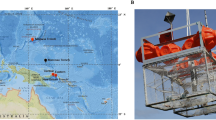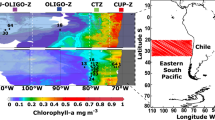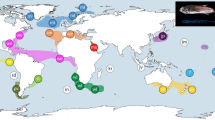Abstract
The physical uniformity of the deep sea suggests a lack of absolute barriers to faunal dispersal, and thus genetic homogeneity in broadly distributed species is expected. The deep-sea amphipod Eurythenes gryllus Lichtenstein (Crustacea: Lysianassoidea) is considered a panoceanic, cold-water stenotherm, with a vertical depth distribution from 184 to 6500 m. We surveyed mtDNA sequence diversity in E. gryllus to assess genetic diversity and population structure in different oceans and across traditionally defined bathyal and abyssal zones. DNA sequences (437 nucleotides length) from the mitochondrial large-subunit ribosomal RNA gene (16S rRNA) of 95 individuals, collected between 1982 and 1990 from 14 locations in the central North Pacific (including multiple samples on the slope of a seamount), castern and western North Atlantic, and the Arctic Ocean, were obtained. Our analysis of DNA sequence diversity indicates (1) genetic homogeneity among sites within the same depth zone at the scale of ocean basins; and (2) genetically divergent, cryptic taxa distributed at different depths, with the greatest diversity in the bathyal zone. These observations suggest that ecological and physical conditions are important isolating mechanisms that may lead to speciation in this group.
Similar content being viewed by others
References
Allen JA (1979) The adaptations and radiation of deep-sea bivalves. Sarsia 64: 19–27
Avise JC, Nelson WS, Sugita H (1994) A speciational history of “living fossils”: molecular evolutionary patterns in horseshoe crabs. Evolution 48: 1986–2001
Baldwin RJ, Smith KL Jr (1987) Temporal variation in the catch rate, length, color, and sex of the necrophagous amphipod, Eurythenes gryllus, from the central and eastern North Pacific. Deep-Sea Res 34: 425–439
Barnard JL (1961) Gammaridean Amphipoda from depths of 400 to 6000 meters. Galathea Rep 5: 23–128
Barnard JL (1962) South Atlantic abyssal amphipods collected by R. V. Vema. In Abyssal Crustacea. Columbia University Press, New York, pp 1–78
Brasher DJ, Ovenden JR, White RWG (1992) Mitochondrial DNA variation and phylogenetic relationships of Jasus spp. (Decapoda: Palinuridae). J Zool, Lond 227: 1–16
Brown WM, Prager EM, Wang A, Wilson AC (1982) Mitochondrial DNA sequences of primates: tempo and mode of evolution. J Molec Evolut 18: 225–239
Bruun AF (1957). Deep sea and abyssal depths. Mem geol Soc Amer 67: 641–672
Bucklin A, Frost BW, Kocher TD (1995) Molecular systematics of six Calanus and three Metridia species (Calanoida: Copepoda). Mar Biol 121: 655–664
Bucklin A, Wilson RR Jr, Smith KL Jr (1987) Genetic differentiation of seamount and basin populations of the deep-sea amphipod Eurythenes gryllus. Deep-Sea Res 34: 1795–1810
Charmasson SS, Calmet DP (1987) Distribution of scavenging Lysianassidae amphipods Eurythenes gryllus in the northeast Atlantic: comparison with studies held in the Pacific. Deep-Sea Res 34: 1509–1523
Christiansen B, Pfannkuche O, Thiel H (1990) Vertical distribution and population structure of the necrophagous amphipod Eurythenes gryllus in the West European Basin. Mar Ecol Prog Ser 66: 35–45
Clarke AH Jr (1962) On the composition, zoogeography, origin and age of the deep-sea mollusk fauna. Deep-Sea Res 9: 291–306
Crisan D, Mattson JC (1993) Retrospective DNA analysis using fixed tissue specimens. DNA Cell Biol 12: 455–464
Devereux J, Haeberli P, Smithies O (1994) A comprehensive set of sequence analysis programs for the VAX. Nucleic Acids Res 12: 387–395
Etter RJ, Grassle JF (1992) Patterns of species diversity in the deep sea as a function of sediment particle size diversity. Nature 360: 576–578
Etter RJ, Rex MA (1990) Population differentiation decreases with depth in deep-sea gastropods. Deep-Sea Res 37: 1251–1261
France SC (1994) Genetic population structure and gene flow among deep-sea amphipods, Abyssorchomene spp. from six California Continental Borderland basins. Mar Biol 118: 67–77
Gage JD, Tyler PA (1991) Deep-sea biology. Cambridge University Press, Cambridge
George RY (1979) What adaptive strategies promote immigration and speciation in deep-sea environment. Sarsia 64: 61–65
Gilbert DG (1992) SeqApp: a biosequence editor and analysis application. Macintosh Ver. 1.9a169; available via anonymous ftp from ftp.bio.indiana.edu/molbio/seqapp
Grassle JF, Maciolek NJ (1992) Deep-sea species richness: regional and local diversity estimates from quantitative bottom samples. Am Nat 139: 313–341
Hansen B (1967) The taxonomy and zoogeography of the deep-sea holothurians in their evolutionary aspects. Stud trop Oceanogr Miami 5: 480–501
Hargrave BT, Philips GA, Prouse NJ, Cranford PJ (1995) Rapid digestion and assimilation of bait by the deep-sea amphipod Eurythenes gryllus. Deep-Sea Res 42: 1905–1921
Hargrave BT, Prouse NJ, Phillips GA, Cranford PJ (1994) Meal size and sustenance time in the deep-sea amphipod Eurythenes gryllus collected from the Arctic Ocean. Deep-Sea Res 41: 1489–1508
Hessler RR, Sanders HL (1967) Faunal diversity in the deep sea. Deep-Sea Res 14: 65–78
Hessler RR, Wilson GDF (1983) The origin and biogeography of malacostracan Crustaceans in the deep sea. In: Sims RW, Price JH, Whalley PES (eds) The emergence of the biosphere. Academic Press, New York, pp 227–254
Ingram CL, Hessler RR (1983) Distribution and behavior of scavenging amphipods from the central North Pacific. Deep-Sea Res 30: 683–706
Karlsen F, Kalantari M, Chitemerere M, Johansson B, Hagmar B (1994) Modifications of human and viral deoxyribonucleic acid by formaldehyde fixation. Lab Invest 71: 604–611
Kumar S, Tamura K, Nei M (1993) MEGA: Molecular Evolutionary Genetics Analysis. Institute of Molecular Evolutionary Genetics, Pennsylvania State University, University Park, Pennsylvania
Machado EG, Dennebouy N, Suarez MO, Mounolou JC, Monnerot M (1993) Mitochondrial 16S-rRNA gene of two species of shrimps: sequence variability and secondary structure. Crustaceana 65: 279–286
Palumbi SR (1994) Genetic divergence, reproductive isolation and marine speciation. A Rev Ecol Syst 25: 547–572
Palumbi SR, Benzie J (1991) Large mitochondrial DNA differences between morphologically similar penaeid shrimp. Molec Mar Biol Biotech 1: 27–34
Palumbi S, Martin A, Romano S, McMillan WO, Stice L, Grabowski G (1991) The simple fool's guide to PCR. Ver. 2.0. University of Hawaii, Honolulu
Rex MA (1981) Community structure in the deep-sea benthos. A Rev Ecol Syst 12: 331–353
Rex MA (1983) Geographical patterns of species diversity in the deep-sea benthos. In: Rowe GT (ed) The sea. Vol. 8. John Wiley, New York, pp 453–472
Shulenberger E, Hessler RR (1974) Scavenging abyssal benthic amphipods trapped under oligotrophic central north Pacific gyre waters. Mar Biol 28: 185–187
Sibuet M (1979) Distribution and diversity of asteroids in Atlantic abyssal basins. Sarsia 64: 85–91
Thurston MH (1990) Abyssal necrophagous amphipods (Crustacea: Amphipoda) in the northeast and tropical Atlantic Ocean. Prog Oceanogr 24: 257–274
Thurston MH, Bett BJ (1993) Eyelessness in marine gammaridean Amphipoda (Crustacea): geographical, bathymetric and taxonomic considerations. J nat Hist 27: 861–881
White BN (1987) Oceanic anoxic events and allopatric speciation in the deep sea. Biol Oceanogr (NY) 5: 243–259
Wilson GDF, Hessler RR (1987) Speciation in the deep sea. A Rev Ecol Syst 18: 185–207
Author information
Authors and Affiliations
Additional information
Communicated by J. P. Grassle, New Brunswick
Rights and permissions
About this article
Cite this article
France, S.C., Kocher, T.D. Geographic and bathymetric patterns of mitochondrial 16S rRNA sequence divergence among deep-sea amphipods, Eurythenes gryllus . Marine Biology 126, 633–643 (1996). https://doi.org/10.1007/BF00351330
Received:
Accepted:
Issue Date:
DOI: https://doi.org/10.1007/BF00351330




